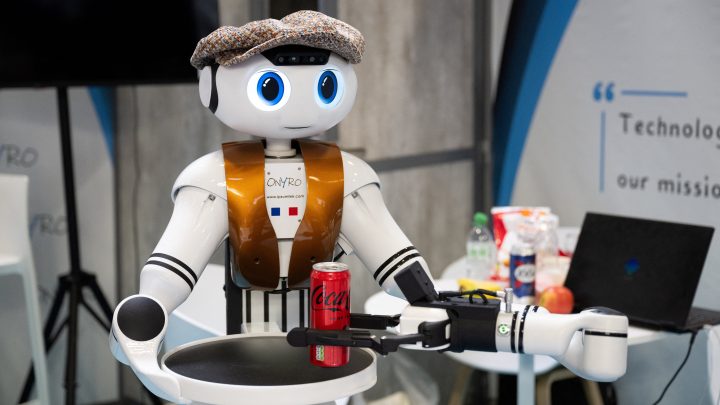
Zoom cashiers may signal a new era of digital offshoring and remote work
Zoom cashiers may signal a new era of digital offshoring and remote work

The idea of offshoring might evoke images of assembly lines and electronic manufacturing in other countries, and that obviously still happens. But thanks to artificial intelligence and other tech advancements, we may be entering a new age of digital offshoring. Take, for example, content moderators in India, or Zoom cashiers in the Philippines.
Whizy Kim is a senior reporter with Vox where she wrote about this phenomenon. She joined Amy Scott of “Marketplace” to talk about what the future of digital automation looks like for workers. An edited transcript of their conversation is below.
Amy Scott: Okay, we’ve got to start with this chicken shop that you visited in the East Village in New York City. Sansan Chicken. Am I saying it right?
Whizy Kim: Yeah, I believe so. Yeah, yeah.
Scott: So, tell us about the customer experience there.
Kim: So I walked in on a Wednesday afternoon. The shop wasn’t super busy and the first thing that I see when I walk in is there isn’t a physical cashier. It’s a screen with a cashier over Zoom. She’s wearing a headset, she looks, you know, like any cashier you might see, but she’s just not physically there. She’s potentially thousands of miles away.
Scott: Wow, and I mean, the first question I asked, of course, is why? Why is there a Zoom cashier?
Kim: I think that’s a great question. So these cashiers are hired by a company called Happy Cashier. And the founder of the company has sort of said, “Well, first of all, you know, we’re trying to just experiment with it and see how it goes. But also, I can’t deny that it is much cheaper to hire someone in the Philippines to be a cashier than it would be to hire a cashier in New York City.”
Scott: Right. So this is another form of offshoring. I mean, we’re familiar with a lot of customer service being offshored, and call centers. But how is this the sign of what you think of as a new era of digital offshoring?
Kim: Well, I think that technology and, specifically, the adoption of technology within an industry, has for a long time in common with this sort of outsourcing or offshoring. So this often happens, because the technology can sort of be used to enable some of the geographical constraints of work to disappear. So people all over the world can do it. And if given the chance, a lot of companies to do that.
Scott: Can you give some other examples of newer forms this is taking?
Kim: Sure. So for example, Amazon’s grocery stores used to have up until very recently, a technology called just walk out, where you don’t have to go to the till and check out your items, you could just walk out with whatever you want to buy, and it will just automatically know which items you had. But then it turned out that oftentimes, those transactions needed to be verified or validated by a whole mass of human workers, many of them in India very far away from, you know, the Amazon grocery stores physically located in the U.S.
Scott: Right, and you talk about the the emergence of so-called “digital sweatshops.” I mean, these jobs are tend to be pretty low paid, what do we know about the working conditions for these tech workers who are doing the behind the scenes work that we attribute to automation.
Kim: You know, it’s an industry that we now call click work, because a lot of it is done through the computer. But it’s also very low paying and that each individual task might not take too long. So they pay, you know, like literal pennies for each task. And you’re supposed to amass as many of these tasks as you can. But you work a full day doing all these digital tasks, and you might still be making less than minimum wage in that country. And sometimes the nature of the work might be just traumatic as with content moderation, or the workers have talked about just being really mentally disturbed, understandably so by the nature of the work that they have to do.
Scott: In your piece, you talk about how workers have responded to technological disruption in the past, going back to the Luddites, destroying machines that they thought threatened their textile jobs, how are workers generally responding to these new technologies now?
Kim: I think that there is more weariness over how things like AI could be used against workers, especially among creative jobs. So for example, with the Writers Guild of America last year, it was during the Hollywood strike. AI was one of the central components of you know, what they were bargaining for. They didn’t want AI to be credited as a writer, they didn’t want AI created writing to be used as source materials. And in the case of like, click work and AI training. A lot of the jobs are sort of what’s considered gig work today. They’re not considered employees. They don’t get all of the labor protections that employees have a more traditional employment model would get often automation and the degradation of labor comps for work that is already pretty vulnerable to this sort of worsening.
There’s a lot happening in the world. Through it all, Marketplace is here for you.
You rely on Marketplace to break down the world’s events and tell you how it affects you in a fact-based, approachable way. We rely on your financial support to keep making that possible.
Your donation today powers the independent journalism that you rely on. For just $5/month, you can help sustain Marketplace so we can keep reporting on the things that matter to you.











